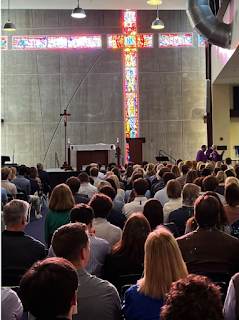At the end, but not yet finished
Holy Saturday is the one day a year on which there is neither Mass nor a Liturgy with already consecrated hosts, as on Good Friday. Today the Church still prays (see the Liturgy of the Hours for today), but there is far more silence, there is not a Eucharist to gather the people. Like the apostles after Christ’s death, we sit apart, scattered, to remember in quiet and solitude the death of the one who has loved us more than any other in the world.
Therefore, in lieu of a meditation on Scripture readings, I would like to consider a dying renaissance master’s meditation. We are familiar with Michelangelo’s Pietà in St. Peter’s Basilica, perfected and polished by a Michelangelo in his twenties. Perhaps lesser known is the unfinished Rondanini Pietà, which Michelangelo began in his mid-seventies and was still carving days before his death at the age of 89.
I got to see this sculpture in person a little over a month ago with some of our students and the intrepid Lisa Druebert. Sitting in the Milanese museum which houses the Rondanini Pietà, I could tell that I was in the presence of a profound work of art. But the fact that it was unfinished, that I couldn’t see the depths and details of the faces, that much of the bodies of Christ and Mary were still trapped in the marble, kept the piece from engaging my mind as much as the other art we saw. I could just sit, and look, and feel (though without much understanding) that I was in the presence of someone’s deep contemplation on the broken body of Christ and the shattered heart of his Mother.
This is somewhat how I feel at the end of this Lent, on the last day of prayer over Christ’s sufferings, after the whole span of Lent. The busy-ness of travel, teaching, grading, etc. have made this Lent shoot by faster than I remember previous Lents doing. It feels like Ash Wednesday was last week, and that I have barely scratched the surface of meditating on the Passion of Our Lord. Thus, the image of an 89-year-old Michelangelo, lifting his hammer and chisel to this block of marble at the end of a long life, thinking about how it has passed too quickly, and how he has not yet finished his contemplation of Christ’s sufferings, leaves me with the comfort of knowing that I am not the only one. Today, we can all take a moment of silence, imagine once more that first Holy Saturday, picture the scattered disciples, and see (if only dimly, if only for a moment) Mary wanting to hold her beloved son once more. Let us stop, behold, and feel, even if we cannot fully understand, what was the cost of our salvation.
Therefore, in lieu of a meditation on Scripture readings, I would like to consider a dying renaissance master’s meditation. We are familiar with Michelangelo’s Pietà in St. Peter’s Basilica, perfected and polished by a Michelangelo in his twenties. Perhaps lesser known is the unfinished Rondanini Pietà, which Michelangelo began in his mid-seventies and was still carving days before his death at the age of 89.
I got to see this sculpture in person a little over a month ago with some of our students and the intrepid Lisa Druebert. Sitting in the Milanese museum which houses the Rondanini Pietà, I could tell that I was in the presence of a profound work of art. But the fact that it was unfinished, that I couldn’t see the depths and details of the faces, that much of the bodies of Christ and Mary were still trapped in the marble, kept the piece from engaging my mind as much as the other art we saw. I could just sit, and look, and feel (though without much understanding) that I was in the presence of someone’s deep contemplation on the broken body of Christ and the shattered heart of his Mother.
This is somewhat how I feel at the end of this Lent, on the last day of prayer over Christ’s sufferings, after the whole span of Lent. The busy-ness of travel, teaching, grading, etc. have made this Lent shoot by faster than I remember previous Lents doing. It feels like Ash Wednesday was last week, and that I have barely scratched the surface of meditating on the Passion of Our Lord. Thus, the image of an 89-year-old Michelangelo, lifting his hammer and chisel to this block of marble at the end of a long life, thinking about how it has passed too quickly, and how he has not yet finished his contemplation of Christ’s sufferings, leaves me with the comfort of knowing that I am not the only one. Today, we can all take a moment of silence, imagine once more that first Holy Saturday, picture the scattered disciples, and see (if only dimly, if only for a moment) Mary wanting to hold her beloved son once more. Let us stop, behold, and feel, even if we cannot fully understand, what was the cost of our salvation.
Author: Thomas Croteau, S.J., Theology Department



Comments
Post a Comment